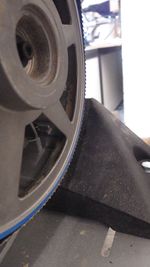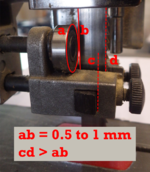Vertical Bandsaw Introduction
This is the content required for an introduction to our bandsaws - reading this does NOT replace the mandatory session with a tutor! It will make it a lot quicker though ;-)
Let's begin! First off, make sure you have read the machine's manual (see respective "InfoBox" on the machine page).
Safety
Dangers
- entanglement hazard!
- sharp, quickly moving blade that is only held in place by its own tension
- small splinters can fly towards the operator
- the sawblade can snap when you pull the workpiece back [1] or it becomes dull
- the blade can bind with the workpiece: there is no splitter as on the table saw
- if you want to cut off thin parts that can bend, make sure the thicker part is on the fence's side of the blade
Precautions
- wear personal protection
- definitely goggles and ear defenders!
- dust mask: depending on the material you are cutting - special caution when working with toxic woods (e.g. Eiche, Esche, Eibe, Buche, Buchsbaum)
- gloves: make an informed decision (as with the table saw)
- some sources say you should wear them to protect yourself against splinters which could surprise you and make your hand flinch in a dangerous position
- others prohibit the use of gloves as your entire hand could be dragged into the blade if one gets caught
- do not wear loose clothing or jewellery and keep long hair under a hairnet or in a tight bun
- keep all body parts at least a hand's width away from the blade whenever the saw is running
- use push sticks whenever your hands would otherwise come too close to the blade
- never use without installed safeguard
- immediately report and remove a dull blade
- always unplug the saw and wait for the blade to grind to a halt before opening the case of the machine
- check the blade for cracks, bends or foreign particles and make sure that the teeth are pointing downwards before starting
- lower the top blade guide (obere Sägeblattführung) as close as possible down to the workpiece (about 5 mm) so a snapped blade does not have a lot of space to cause damage in
- use a parallel fence, push stick and a jig/wedge when sawing round workpieces
Suggested Reading
Besides these safety notes, you should know about the different types of bandsaw blades in order to pick the proper one for your project.
Useful links:
- "Arbeitsschutz Kompakt Nr. 39" der BGHM (DE)
- nice illustration of machine parts and blade guide positioning
- HolzWerken.net: Einstellung der Blattführungen (DE)
Demonstration
The tutor will show you these steps in detail (the order 1-2-3 is important):
- 1) adjusting the blade tension:
- turn the tensioning screw until the indicator points to the width of the blade
- the scale on the saw is usually not very reliable though, so you may want to refine it using the "flutter method"
- wider blades need more tension
- release the tension after you're done using the saw to increase blade lifespan
- turn the tensioning screw until the indicator points to the width of the blade
- 2) check proper tracking on the guide wheels (adjust the top wheel's tilt angle, if necessary)
- the blade should not wander left or right when you turn the wheels by hand
- the teeth should not be in contact with the wheels (otherwise, they can be bent)
- flat wheels: blade should run with the teeth extending over the edge
- crowned ("rounded") wheels: blade should run central on crowned wheels ("back" on the high point, teeth free)
- 3) adjusting the blade guides: [2]
- guide blocks (or bearings in some machines) should lightly touch the back of the blade but not the teeth (you can use the same paper trick as for calibrating a 3D printer or CNC router)
- leave a small gap (0.5-1 mm, about the thickness of a credit card) to the thrust bearing behind the blade
- the distance from the teeth's base to the guide blocks needs to be larger than the gap from the blade's back to the thrust bearing (> 1 mm)
- repeat this with the lower guide
- bring the top guide down to just about 5 mm above your workpiece
- folding a blade for storage
- switching to disc sander mode on the Metabo BS 1638 W (not yet possible - missing table!)
Waiting List
This introduction takes longer than many others and usually can't be done spontaneously during regular opening times. If you would like to receive it, please add yourself to >> this list << and we will find a good time once a few members are on it!

